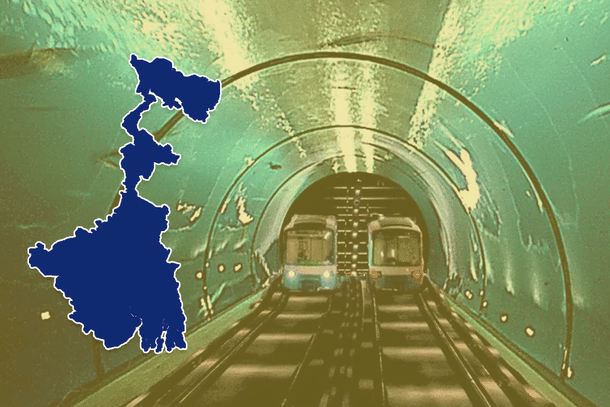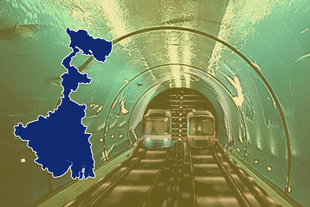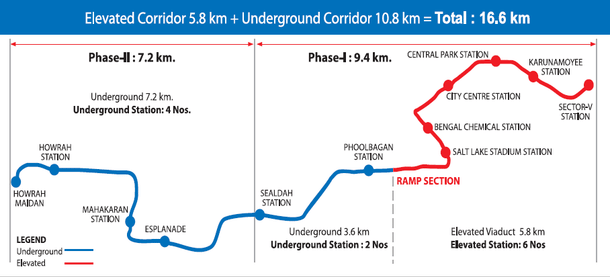Infrastructure
A Milestone: Trial Run Of India's First Underwater Metro Starts In Kolkata's East-West Corridor, Commercial Operations To Begin This Year
V Bhagya Subhashini
Apr 13, 2023, 09:59 AM | Updated 11:37 AM IST
Save & read from anywhere!
Bookmark stories for easy access on any device or the Swarajya app.


India’s first underwater Metro Rail below the river Hooghly in Kolkata made its first maiden journey from Mahakaran to Howrah through a water tunnel 32 metres below water level.
The General Manager of Metro Rail, P Uday Kumar Reddy, and other senior officials of Metro Rail and the Kolkata Metro Rail Corporation, took a ride from Mahakaran to Howrah Maidan station.
The trail run crossing the Hooghly river and was completed around 11.55am on Wednesday (12 April).
The India's first underwater metro trial run of 4.8km from Howrah Maidan to Esplanade is considered a historic moment as Kolkata is the city which got its metro first in the country in 1984.
According to Reddy, the trial runs between Howrah Maidan and Esplanade will last for the following seven months until regular services on this stretch start. On this length, it's anticipated that commercial services will start this year.
Kolkata Metro creates History!For the first time in India,a Metro rake ran under any river today!Regular trial runs from #HowrahMaidan to #Esplanade will start very soon. Shri P Uday Kumar Reddy,General Manager has described this run as a historic moment for the city of #Kolkata. pic.twitter.com/sA4Kqdvf0v
— Metro Rail Kolkata (@metrorailwaykol) April 12, 2023
India's First Underwater Metro Service
India's first underwater metro service is part of Kolkata’s East-West Corridor Project. The East West Metro Project will link Sector V with the Howrah Maidan on the other side of the Hooghly river. It is being built at a cost of Rs 8,600 crore.
The key portion of the project is a 520-metre underwater tunnel, which is located in the 10.8 km long underground section. The underwater metro train has been compared to the Eurostar, which connects London and Paris.
The commuters will move quickly through the water, covering roughly 500 metres in less than a minute.
When completely operational, trains will travel through the river tunnels at 80 kph and take 6 minutes to get from Howrah Maidan to Esplanade.
In 2017, the tunnelling project under the Hooghly river bed was successfully finished by construction major Afcons.
The underwater section will consist of twin tunnels made of 1.4 m-wide concrete rings. The tunnels include hydrophilic gaskets to further prevent water from getting inside.
Leading design firms like Atkins, Systra, and Tunnel Consult collaborated on the project.
Tunnel boring machines (TBMs) made by Herrenknecht were ordered. In the event of even a small water intrusion, the TBM would shut down like a submarine. British safety regulations were observed.
Trains will operate 26 metres below ground level at the tunnel's bottom, which is 36 metres from the water's surface.

Deepest Metro Station In India- Hoogly Station
Commercial services are anticipated to commence this year on the stretch. The opening of this stretch will make Howrah Metro station the deepest in the country, located 33 metres underground.
At present about 9.1 km of the East West Metro line from Salt Lake Sector V to Sealdah is operational. Services of East West Metro Railway was started in phases with first phase in February 2020 and the latest in July 2022, reports The Hindu.
After the trial run, regular Metro service from Howrah Maidan to Saltlake Sector V will reduce traffic congestion and provide quick transportation to passesngers.
Delays In The Project
The project's foundation stone was placed in February 2009, and its completion date was set for October 2014. Realignment caused the work to stop from 2012 to 2015. Weak geology and a crowded topography caused many difficulties for East-West Metro Corridor.
On 31 August 2019, a tunnel boring equipment struck an aquifer, causing severe earth subsidence and the collapse of numerous nearby buildings.
The project was initially expected to be completed by December 2021, but has been delayed because of mishaps that occurred at Bowbazar in central Kolkata while tunnelling work was being done.
In May, nearly three years after a similar event there, numerous residences experienced cracks while underground work was being done.
V Bhagya Subhashini is a staff writer at Swarajya. She tracks infrastructure developments.





